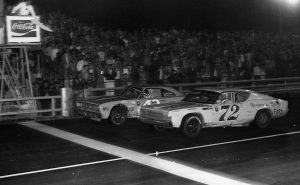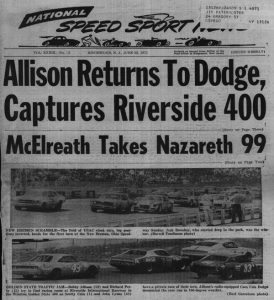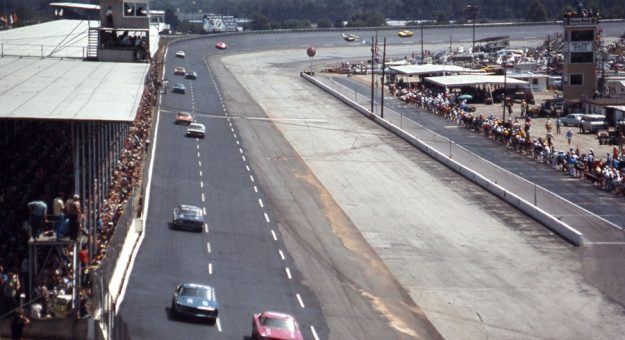Editor’s Note: NASCAR is celebrating its 75th anniversary in 2023. SPEED SPORT was founded in 1934 and was already on its way to becoming America’s Motorsports Authority when NASCAR was formed. As a result, we will bring you Part 24 of a 75-part series on the history of NASCAR as told in the pages of National Speed Sport News and SPEED SPORT Magazine.
Winners are admired, adored, envied and despised.
Two Winston Cup championships, 119 career victories and nearly $1 million in career earnings, even before the start of the 1971 season, brought Richard Petty the adulation of NASCAR fans, but his unparalleled success also made him the target of his competitors.
Petty began the season on the pole of the Motor Trend 500 road race at California’s Riverside Int’l Raceway, but lost his engine on the 107th lap and settled for 20th. Next was Speedweeks in Daytona Beach, Fla., and the Daytona 500, which Petty won in 1964 and ’66.
While three-time Indianapolis 500 champ A.J. Foyt appeared in control of the race with 39 laps to go, he ran out of fuel, coasted into the pits and returned to the race one lap down in eighth place. This moved Petty into third behind Donnie Allison and thebother Petty Enterprises entry driven by Buddy Baker.
As Allison and Baker swapped the lead back and forth over the next nine turns, Petty waited for his chance. A lap-163 caution flag for former teammate Pete Hamilton’s engine failure and Allison’s accident brought him to Baker’s rumper. The Randleman, N.C., cohorts raced side-by-side until Petty took the point for the final time on the 181st lap.
Although Petty won the Daytona 500 for a then-record third time, it was the Plymouth Road Runner’s second visit to victory lane in 1971, which ignited the Petty bashing. Prior to the March 7 Richmond (Va.) 500, Petty, Benny Parsons and Charlie Glotzbach were banned from qualifying because their engines were too close to their dashboards. However, all three would be allowed to race if their cars could be redesigned in time.
The Petty team worked all night, but could not redesign the engine mounts to meet NASCAR specifications, so the No. 43 car was forced to race with a one-inch carburetor restrictor plate as a handicap and started last in the race. Yet, the handicap failed to slow the car which Petty had in fifth by the 30th lap and in first on the 234th tour around the .542-mile oval. When “The King” finished first, the controversy started.
The March 17 issue of NSSN asked the question, “ls Richard Petty being given preferential treatment, as some drivers contend, or are he and his crew simply superior?”

Was Petty NASCAR’s Promotional Tool?
After Petty’s “handicapped” victory in Richmond, many felt Petty’s good looks and pleasant personality were being used by NASCAR as a promotional tool and the sanctioning body wanted him in the winner’s circle whether his car conformed to the specifications or not.
Harry Hyde, crew chief for defending Winston Cup champion Bobby Isaac, was one of those people. “It’s like Joe Frazier fighting Muhammad Ali (on March 8) with one hand tied behind his back,” Hyde said of racing against Petty. “I wish they’d throw away the rule book and let us go out and race.”
Petty denied favoritism on the part of the sanctioning body and offered Petty Enterprises’ two decades of racing experience and his competitiveness as the real reason behind his success.
“I go out to beat (every car),” Petty said. “I’ve won 121 races. I’ve also lost 400. My feeling is that nobody has ever done anything that someone can’t do better. Ali thought he was the greatest, but Frazier knocked his head off. He might’ve been the greatest yesterday or today, but maybe not tomorrow.”
Petty continued his great racing with victories in the Carolina 500 at Rockingham, N.C., and in Hickory, N.C., and took the points lead from Isaac. With the Richmond victory as his first, he may have won four races in a row had he not lost a full lap to eventual Southeastern 500 (Bristol, Tenn.) victor David Pearson after the No. 43 car’s right front tire blew.
Luckily for Petty, driver dissatisfaction with the year-old NASCAR restrictor-plate rule superseded any ill will they may have held against him. In 1970, restrictor plates were introduced to reduce speeds on superspeedways. The new rule was accepted with the standard amount of grumbling until Pearson won the second of two 125-mile qualifying races for the Daytona 500 with a larger plate than was legal.
Restrictor Plates Cause Drama
Now, suspicions arose about the legality of every driver’s restrictor plates.
The K&K Insurance team, owned by insurance magnate Nord Krauskopf and run by Hyde, went so far as to pull Isaac’s car off the Winston Cup circuit until they were satisfied the rules were equally enforced for all competitors. Independent driver James Hylton called the restrictor-plate rule unfair and threatened to retire rather than race at what he considered a disadvantage.
The Wood Brothers team later parked Donnie Allison and occasional NASCAR driver A.J. Foyt’s cars in part because of the perceived and actual inequity between the one and five-eighths-inch opening in the Chrysler restrictor plates and the one-and-a-quarter-inch Ford plates.
Petty explained the drivers’ position: “If they are going to run plates, then everyone should have the same size plate.”
NASCAR replaced restrictor plates with equal carburetor base openings effective Aug. 15, Bill France promised to return to restrictor plates if the new plan did not keep speeds down and competition even. Nearing the halfway mark of the Grand National schedule, Petty held nine victories in 21 races and stood atop the points.
Petty appeared poised to run away with the season, much as he had in 1967, until Bobby Allison climbed behind the wheel of a Holman-Moody Mercury. Pearson was Holman-Moody’s top driver with two victories and seven top-10s entering May. But a three-year, $300,000 offer from millionaire Chris Vallo, who was financing Ray Nichels’ Pontiac entries, lured him away.
This opened the door for Dodge-man Allison to move to the Ford team.
Allison’s Success Sparks Bitter Rivalry
Success was immediate for Allison. He won his first race of the year in a Mercury just three weeks after joining the Holman-Moody team. His World 600 victory began a string of three straight in a Mercury. While he added two more to that run in a Dodge, the remainder of Allison’s 11 triumphs in 1971 were behind the wheel of a Ford product.

Allison’s sudden emergence sparked a bitter rivalry between NASCAR’s Most Popular Driver (Allison) and the fan favorite (Petty), who rattled off his own five-victory streak in July. This competition hit a torrid peak during the latter half of the Aug. 8 race in Ona, W. Va.
The No.· 43 Plymouth Road Runner started the 227.5-mile race directly behind Allison’s red-and-black Ford Mustang and the battle started with Petty punting Allison out of the way on the to take the point. Allison returned the favor to the delight of the packed grandstands. The climax to the rough-and-tumble exchange came late in the race with the two cars flying down the track exchanging paint.
Allison refused to yield the lead to Petty until his No. 12 Coca-Cola car was pinned against Wendell Scott’s Ford. Petty then streaked to victory.
It was only one of the many battles the drivers fought over the course of the season.
However, Petty, who became the first NASCAR driver to surpass $1 million in career earnings, pocketed an extra $20,000 as the first Winston Cup point champion. His 21 victories and 41 top-10 finishes also topped the division. Independent Ford driver James Hylton was second despite a winless season and Cecil Gordon was third.
Allison’s strong second-half run propelled him to fourth in the standings as he won seven races of 400 miles or longer and picked up 31 top-10 finishes. In NASCAR’s other divisions, Motor Trend 500 victor Ray Elder won the Western Grand National division while Jerry Cook won the modified title. Tiny Lund, at 6-feet-5, towered over the competition and Red Farmer won the Late Model Sportsman division again.
Richard Petty’s 1971 Winston Cup championship added to the run which would make him the greatest stock car driver in NASCAR history.
